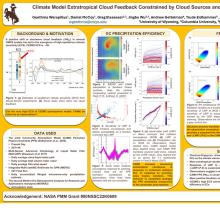Constraining CAM6 cloud feedback by cloud sources and sinks in extratropical cyclones
Geethma
Werapitiya
University of Wyoming
Poster
Our lack of ability to predict the change in shortwave (SW) radiation reflected to space by clouds in response to warming hobbles our predictions of future climate. Constraining extratropical SW cloud feedback which had a positive shift in CMIP6 compared to CMIP5, using observations is important to offer more accurate predictions of climate change. We constrain the cloud feedback resulting from increasing liquid water path due to Clausius-Clapeyron driven moisture convergence flux in extratropical cyclones (ECs). We analyze precipitation in ECs to learn about extratropical condensed water sink processes, combined with observations of clouds and moisture convergence, and use the analysis to better understand the climate sensitivity. We utilize precipitation data from Integrated Multi-satellitE Retrievals for GPM (IMERG) and liquid cloud mass quantified using the NASA MEaSURES funded Multisensor Advanced Climatology of Liquid Water Path (MAC-LWP), which provide a global, diurnally-resolved multidecade description of changes in liquid cloud. We use radiative efficiency as an added constraint with EC precipitation efficiency. To evaluate the microphysical effect on clouds and precipitation in a GCM, we examine output from the CAM6 perturbed parameter ensemble (PPE). A Gaussian process emulator is applied to PPE to provide a constraint on extratropical SW cloud feedback and interpretation of the high climate sensitivity of CESM2.

Werapitiya-Geethma-Poster.pdf
(4.92 MB)
Meeting homepage
